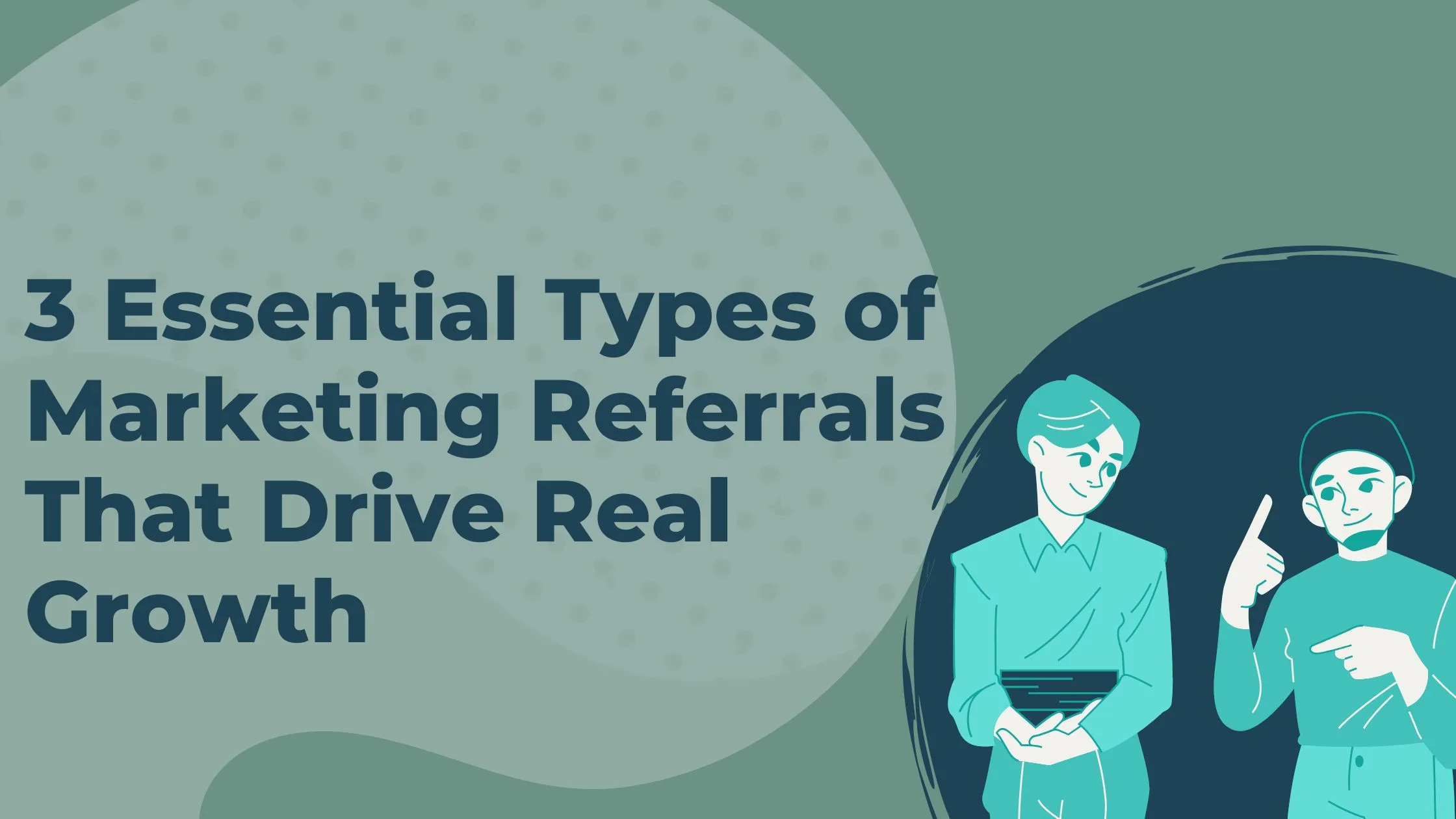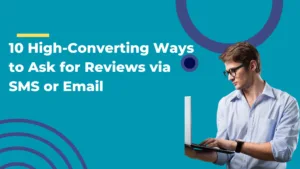What if you could grow your customer base significantly—without increasing your marketing budget? That’s the true advantage of referrals: cost-effective, trust-based, and often outperforming paid ads.
Referral marketing is one of the most powerful organic strategies, especially for businesses looking to scale without overspending. It leverages the most authentic kind of promotion—personal recommendations from satisfied customers.
When someone hears about your brand through a friend or peer, there’s an immediate layer of trust. Unlike paid advertisements, referrals come with genuine credibility. Think about it: are you more likely to trust a polished ad or a suggestion from someone who’s already used the product or service?
In this guide, we’ll break down the three key types of referrals every business should understand: direct referrals, incentivized referrals, and review-based referrals. Plus, we’ll touch on how additional approaches like networking referrals, affiliate programs, and organic advocacy can fuel lasting, sustainable growth for your brand.
Growth Boosters: The 3 Key Referral Marketing Types and How to Use Them
Referrals aren’t all created equal — and they rarely happen by accident.
To build a strong and scalable referral system, you need to understand how and why people talk about and promote brands in different ways.
Below are the three major referral types in marketing and practical tips on how to use each one effectively:
1. Incentivized Referrals (Including Affiliate Referrals)
Incentivized referrals involve offering a reward to individuals who refer others to your business. This could be a discount, gift card, or even a free service. Affiliate referrals fall under this category as well — where partners earn a commission for each sale they bring in.
While direct referrals happen naturally, incentivized and affiliate referrals are fueled by clear motivation. You’re providing an appealing reason for someone to spread the word about your brand.
Many brands actively use this strategy to increase their customer base and drive conversions. Here are some popular examples:
- Dropbox: Offers up to 16 GB of additional storage to users who refer others. Referees also receive a bonus of 500 MB.
- Airbnb: Gives out travel credits that users can apply to future bookings after successful referrals.
- Wise: Awards up to £75 to users who successfully refer three others who transfer at least £200 each.
What Is Affiliate Marketing?
Affiliate marketing is a structured, performance-driven version of incentivized referrals. Rather than casual word-of-mouth, affiliates actively promote products through their platforms using trackable links or coupon codes. They earn a commission for every resulting sale.
The performance-based nature of affiliate marketing makes it attractive, especially for businesses looking to expand outreach efficiently. It works especially well for digital goods and eCommerce since sales can be tracked instantly.
The most effective affiliate partnerships come from having a clear offering, a competitive commission plan, and access to promoters with aligned audiences. When done right, affiliates become trusted ambassadors — not just short-term marketers.
Why It’s Effective
1. Scalable
Once your referral system is set up, it largely runs on its own. Happy customers can continue referring others without additional effort from your team.
Referral systems help sustain a pipeline of leads driven by consistent, trusted word-of-mouth.
2. Trackable
Tracking links, unique referral codes and affiliate dashboards let you see who referred whom, how much was spent and which rewards were issued.
This clarity helps fine-tune your strategy and ensures you’re rewarding performance backed by real data.
3. Motivates Engagement
Customers who like your brand might not automatically promote it — but a compelling incentive gives them a reason to.
Incentivized referrals turn satisfied customers into proactive advocates.
How to Launch an Incentivized Referral Program
- Build a structured referral program: Keep it simple, like “Refer a friend — earn $5 credit when they spend $10.”
- Link it with loyalty rewards: Let referrals count toward future benefits. This keeps customers returning and sharing over time.
- Use tiered rewards: Recognize top performers with special bonuses or perks to keep their momentum going.
- Support your referrers: Offer promotional materials, sample messages, or branded graphics to help them refer with ease and consistency.
2. Direct Referrals
Also known as word-of-mouth, direct referrals occur when a customer personally recommends your business to someone in their circle. These recommendations are typically spontaneous — like a friend suggesting a café during a chat, a colleague recommending a CRM tool during a meeting, or a neighbor praising their trusted plumber.
Word-of-mouth is a powerful marketing tool and is responsible for a large portion of purchase decisions.
According to recent studies, 36% of online users discover new brands and services through word-of-mouth — showing it not only influences decisions but also introduces people to new options.
Despite its reputation as an “old-school” tactic, word-of-mouth remains incredibly effective even in today’s digital world.
Why Direct Referrals Are So Effective
Trust
Recommendations from family or peers feel authentic. Unlike brand messages, these suggestions often come from a genuine desire to help — not to sell.
Social Proof
Positive experiences shared by others suggest credibility and quality, especially when the source is someone you respect.
Lower Risk
Knowing someone you trust had a great experience with a product or service minimizes your doubts and reassures your choice.
Authenticity
These endorsements come off as more real — unscripted stories rather than polished ads.
Emotional Impact
Let’s say you’re considering trying a new eatery. One option is a social ad that says:
“Serving fresh, flavorful noodles.”
Now imagine a friend says:
“You have to try this place — it’s the closest I’ve had to real Italian food outside of Rome!”
Which one would move you to act?
Personal anecdotes make referrals more memorable and convincing. They’re experiences, not taglines — and that human touch leaves a lasting impression.
Why Direct Referrals Matter
- They’re deeply trusted. With no sales agenda, people trust recommendations from real relationships.
- They convert well. Leads generated this way already have a baseline level of trust.
- They foster loyalty. Customers who refer others stick around longer and bring more value. Wharton’s research even found referred clients have a 25% higher lifetime value and are 18% less likely to churn.
This referral method is especially effective in industries where relationships and trust are key — such as services or high-value purchases.
How to Boost Direct Referrals
- Offer standout products/services. When people love what they get, they naturally talk about it.
- Go beyond expectations. Excellent support creates lasting impressions customers want to share.
- Make it simple to refer. Use easy-to-send templates or links to encourage referrals.
- Use social media smartly. Ask customers to tag you in posts or share their stories, helping boost reach organically.
- Tap into your professional network. Not all referrals come from buyers. Partners, vendors, and peers often recommend businesses during conversations.
To encourage this:
- Stay present in your industry and community.
- Be clear about who you help and what makes you different.
- Refer others where appropriate — it builds reciprocity.
- Set up referral partnerships. Team up with complementary businesses for mutual benefit. For instance, a photographer may refer a designer, and vice versa.
3. Review-Based Referrals
Review-based referrals occur when customers speak positively about your business through public platforms like Google Business, Yelp, or review sections on your website. These endorsements may come in the form of reviews, testimonials, or user-generated content.
While they might not carry the same personal influence as direct referrals, reviews are highly impactful. They can reach a much wider audience and play a major role in shaping your online reputation and improving your search visibility.
Why Review-Based Referrals Are Effective
1. They Act as Social Proof
Most buyers check reviews before committing to a purchase. It’s often the first step in their decision-making process. Research published in 2022 by Frontiers revealed that online reviews reduce uncertainty and increase buyer trust — making them a powerful influence.
2. They Build Trust Early
Even before potential customers interact with your business, authentic reviews help establish credibility. According to ScienceDirect, peer recommendations can create trust early in the customer journey — even without direct engagement.
3. They Boost Local Search Ranking
Google considers both the quantity and quality of your reviews when determining local search rankings. A steady stream of positive feedback not only enhances visibility but also drives more traffic without increasing advertising costs.
4. They Prompt Conversions
Great reviews can tip the scale for undecided customers. According to the International Journal of Research and Analytical Reviews (IJRAR), positive feedback often encourages users to follow through on their purchase decisions.
How to Encourage Review-Based Referrals
1. Ask at the Right Moment
Timing your request is key. The best time to ask for a review is shortly after a customer has had a positive experience. For online orders, a follow-up text or email works well. In physical interactions, staff can request reviews directly after a successful transaction.
2. Make the Process Easy
The easier it is to leave a review, the more likely customers are to do it.
“Send review requests via SMS, email or even QR codes to simplify the process,” advises Tim Clarke, Senior Reputation Manager at Thrive Local.
Encourage customers to write meaningful reviews by prompting them to reflect on specific aspects like service, product quality, or overall experience. And always include direct links to your review platforms.
3. Use Testimonials as Content
Customer reviews are a valuable type of user-generated content (UGC). In a world where AI-written content is everywhere, real voices matter more than ever. Reviews give your brand a human touch that builds trust and authenticity.
A survey by The Drum found that:
- 86% of consumers trust brands more when they showcase UGC
- 82% are more likely to buy from brands that feature UGC in their marketing
Leverage reviews in:
- Email campaigns
- Social media posts
- Paid social ads
- Landing pages
Highlighting authentic customer feedback helps attract new buyers and encourages even more people to share their experiences — resulting in a steady stream of impactful review-based referrals.
4. Request Other Forms of User-Generated Content
While written testimonials are impactful, visuals can often speak louder — especially for audiences who respond better to images and short videos than lengthy text.
Photos and videos bring an added layer of authenticity by showing real customers using your product or service in real-life scenarios. This type of UGC helps build trust, forge emotional connections and make your brand feel more relatable — all of which can guide purchase decisions.
Encourage users to share photos of your product in action, unboxing experiences or before-and-after transformations.
Ask them to tag your business in their social posts or videos where they talk about your offerings. With permission, you can reuse these visual assets just like written reviews — by incorporating them into your social media, website, advertising and email campaigns.
5. Always Respond to Reviews
Engaging with both positive and negative reviews shows that you value customer feedback. Responding also encourages more people to leave reviews, knowing their voices will be heard.
6. Use Feedback Surveys
Surveys offer a structured way to learn how customers feel about their experience. They help pinpoint strengths, areas for improvement, and opportunities for building loyalty.
Surveys can also help you identify satisfied customers who may be willing to leave public reviews — converting private feedback into visible social proof.
“Try a two-step strategy,” says Clarke. “First, collect feedback or reviews. Then, follow up with those who had positive experiences and ask for referrals — ideally 30 to 90 days later — to build a lasting referral pipeline.”
Creating a Well-Rounded Referral Strategy
No single referral method stands alone. To fully unlock the potential of referral marketing, your approach should integrate all three types:
• Direct referrals deliver leads that come with built-in trust.
• Incentivized referrals increase volume and encourage repeat participation.
• Review-based referrals enhance visibility and foster credibility organically.
By blending these strategies, you’ll attract a steady stream of potential customers who land on your website ready to buy — already informed and influenced by peer recommendations.
Leverage Referrals for Real Business Growth With Web Believers
Referral strategies don’t need to be complex — but they do require the right plan. If you’re not sure where to begin or how to scale what you already have, Web Believers is here to help.
Our team specializes in building and optimizing referral programs that combine direct outreach, incentives and review-based momentum. Whether you’re launching something new or fine-tuning an existing system, we’ll support you in turning word-of-mouth into sustainable growth.
Ready to transform happy customers into brand ambassadors? Get in touch with Web Believers today and let us help you amplify your business through smart, strategic referrals.
Frequently Asked Questions (FAQs)
1. What are the three main types of marketing referrals?
The three primary types of marketing referrals are:
- Direct referrals, where satisfied customers personally recommend your business.
- Incentivized referrals, where people are rewarded for referring others.
- Review-based referrals, which rely on public reviews and testimonials to influence potential buyers.
2. Why are referrals important for business growth?
Referrals bring in high-quality leads who are more likely to convert. They come with built-in trust, often cost less than traditional marketing, and help build a strong brand reputation over time.
3. How do review-based referrals impact online visibility?
Search engines like Google consider the quality, quantity, and frequency of reviews when ranking local businesses. Positive reviews improve SEO, increase trust, and attract more organic traffic to your website or listing.
4. Can small businesses benefit from referral marketing?
Absolutely. Referral marketing is especially valuable for small businesses because it offers a cost-effective, trust-driven way to attract new customers without a large advertising budget.
5. How can I encourage more customer referrals?
You can:
- Ask happy customers to refer others
- Offer referral rewards or discounts
- Send follow-up emails requesting reviews
- Make it easy to share referral links or leave feedback
- Publicly showcase testimonials to inspire more engagement




